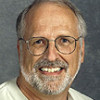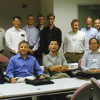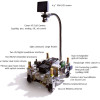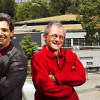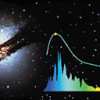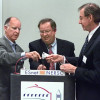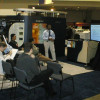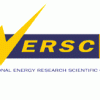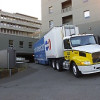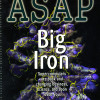NERSC Center News
DOE's NERSC Center Deploys 10 Teraflop/s IBM Supercomputer
The National Energy Research Scientific Computing (NERSC) Center, funded by the U.S. Department of Energy's Office of Science, put its 10 teraflop/s (10 trillion calculations per second) IBM POWER-based supercomputer into service last week, providing researchers across the country with the most powerful computer for unclassified research in the United States. Read More »
David Quarrie Taking Two-Year Assignment to Manage ATLAS Software Project
David Quarrie, head of NERSC's High Energy and Nuclear Physics Computing Group, has accepted a two-year appointment as software project leader within the reorganized computing organization for the ATLAS experiment in Geneva, Switzerland. The ATLAS particle detector, scheduled to begin generating massive amounts of data in 2007, is part of the Large Hadron Collider under construction at CERN, the European Organization for Nuclear Research, the world's largest particle physics center. Read More »
Berkeley Lab Seeking Applicants for Post-Doctoral Fellowship in Computational Science
The U.S. Department of Energy's Lawrence Berkeley National Laboratory is now accepting applications for the Luis W. Alvarez Post-Doctoral Fellowship in Computational Science. The deadline for applications for the coming academic year is Monday, March 3, 2003. Read More »
Lawrence Berkeley National Lab Leads International Team to Win High-Performance Computing Bandwidth Challenge
An international team led by scientists at the U.S. Department of Energy's Lawrence Berkeley National Laboratory achieved their third consecutive victory in the High-Performance Bandwidth Challenge at the SC2002 Conference on high-performance networking and computing. Read More »
Berkeley Lab to Share Computing, Networking Expertise in SC2002 Technical Program and Exhibition
Lawrence Berkeley National Laboratory, a leader in advancing scientific computing for the U.S. Department of Energy, will share its expertise with the high-performance computing and networking community at the SC2002 conference to be held Nov. 16-22 in Baltimore. Read More »
NERSC to Offer 10 Teraflop/s System by Early 2003
The U.S. Department of Energy's National Energy Research Scientific Computing (NERSC) Center has signed a contract with IBM to double the size of NERSC's 3,328-processor RS/6000 SP supercomputer, creating a machine with a peak speed of 10 teraflop/s. Read More »
Creating Science-Driven Computer Architecture: The "Blue Planet" Proposal
In recent years scientific computing in America has been handicapped by its dependence on hardware that is designed and optimized for commercial applications. Lawrence Berkeley and Argonne national laboratories, in close collaboration with IBM, have responded to the challenge with a proposal for a new program to bring into existence a new class of computational capability in the United States that is optimal for science. Read More »
Lawrence Berkeley National Laboratory Team Achieves 10.6 Gigabits/Second Data Throughput in 10-Gigabit Ethernet Test
Although there has been a lot of discussion recently about 10-Gigabit Ethernet capability, actually achieving that level of performance in the real world has been difficult. Until now. a team from Lawrence Berkeley National Laboratory with Force10 Networks (switches), SysKonnect (network interfaces), FineTec Computers (clusters), Quartet Network Storage (on-line storage) and Ixia (line rate monitors) assemble a demonstration system that runs a true scientific application to produce data on one 11-processor cluster, then sends the resulting data across a 10-Gigabit Ethernet connection to another cluster, where it is rendered for visualization. Read More »
Berkeley Lab's RAGE Telepresence Robot Captures R&D100 Award
Berkeley Lab's Remote Access Grid Explorer (RAGE), a remote-controlled robot providing two-way interaction via the global Access Grid, has been named a winner of the 2002 R&D100 Award presented by R&D Magazine. Read More »
Registration Open for September 4-7 Workshop on the DOE Advanced Computational Software Collection
Applications are now being accepted to attend a workshop on "Robust and High Performance Tools for Scientific Computing" sponsored by the U.S. Department of Energy's National Energy Research Scientific Computing Center (NERSC). Read More »
Andreas Adelmann Is NERSC's First Alvarez Fellow in Computational Science
Selected as the first recipient of NERSC's Luis Alavarez Postdoctoral Fellowship in Computational Science, Adelmann, his wife and three children recently moved into a home in North Berkeley. Read More »
IBM and Department of Energy Supercomputing Center to Make DOE Grid Computing a Reality
IBM and the U.S. Department of Energy's (DOE) National Energy Research Scientific Computing Center (NERSC) today announced a collaboration to begin deploying the first systems on a nationwide computing Grid, which will empower researchers to tackle scientific challenges beyond the capability of existing computers. Read More »
NERSC's Peter Nugent Named to Hubble Space Telescope Users Committee
Peter Nugent, an astrophysicist in NERSC's Scientific Computing Group who made news last year as co-discoverer of the oldest supernova ever found, has been asked to join the Hubble Space Telescope Users Committee. The committee is an international panel of 12 scientists who serve for three years. Read More »
Colliding Black Holes, Dancers, and Electron Microscopy Push Network Boundaries by Moving Billions of Bits in Network Bandwidth Challenge at SC2001 Conference
For the second year in a row, a team led by high-performance computing experts from the U.S. Department of Energy's Lawrence Berkeley National Laboratory took top honors in a contest to move the most data across the network built around SC, the annual conference of high-performance computing and networking which concluded Nov. 16. The winning application was a live visualization of a simulation of colliding black holes. Read More »
RAGE Rolls Out in Denver
At the SC2001 supercomputing conference held in Denver, Colorado, November 12-16, visitors are likely to encounter a roaming robot named RAGE. Despite its fearsome moniker, RAGE is intended to be a convivial sort of critter, built specifically for the purpose of extending the reach of the group-communication tool known as the Access Grid to people and events far from the Grid's fixed "nodes." Read More »
Lawrence Berkeley National Laboratory to Present Leading HPC Experts in Series of Talks at SC2001 Conference
Some of the nation's leading experts in high-performance computing and computational science will be featured in a series of talks presented in the Lawrence Berkeley National Laboratory booth at the SC2001 conference to be held Nov. 12-16 in Denver. Read More »
NERSC Unveils Global Unified Parallel File System
In a typical high-performance computing (HPC) environment, each large computational system has its own local disk, and access to additional network-attached storage and archival storage servers. Such an environment prevents the consolidation of storage between systems, thus limiting the amount of working storage available on each system to its local disk capacity. The result? An unnecessary replication of files on multiple systems, an increased workload on users to manage their files, and a… Read More »
World's Largest Unclassified Supercomputer Goes Online, Scientists Already Reporting Significant Results
Scientists at universities and national laboratories across the country are now tapping into the power of the world's largest supercomputer dedicated to unclassified research and have reported important breakthroughs in climate research, materials science and astrophysics. Read More »
Nuclear Science and Physics Programs Invest in a Major Expansion of the PDSF Cluster at NERSC
Eighty-two new servers and significant improvements in the overall computing and networking infrastructure will be added this fall to the PDSF (Parallel Distributed Systems Facility), a large Linux-based computer cluster that is currently operated as a partnership between three divisions of the Lawrence Berkeley National Laboratory: Nuclear Science, Physics, and the National Energy Research Scientific Computing Center (NERSC). Computing power will be expanded by 57 dual-processor nodes, and storage capacity will be tripled. Read More »
Berkeley Lab Receives Multi-Million-Dollar Funding to Develop New Computational Tools for Advancing Scientific Research
Scientists at the U.S. Department of Energy's Lawrence Berkeley National Laboratory will help lead the development of a new generation of tools and technologies for scientific computing under a new $57 million program announced today (August 14) by the DOE. Under the program, called Scientific Discovery through Advanced Computing (SciDAC), Berkeley Lab scientists will lead six of the projects and are key partners in another six projects. Read More »
Ranking Shows U.S. Department of Energy's NERSC at Berkeley Lab Has World's Most Powerful Unclassified Supercomputer
In the latest ranking of the world's 500 most powerful supercomputers, a 2,528-processor IBM RS/6000 SP system at the U. S. Department of Energy's Lawrence Berkeley National Laboratory is listed as the top unclassified supercomputer on Earth. Read More »
Berkeley Lab Dedicates First Oakland City Facility
Lawrence Berkeley National Laboratory’s first off-site facility in the city of Oakland, which houses Computing Sciences employees and the high-performance computing and data storage systems of the National Energy Research Scientific Computing Center (NERSC), was dedicated by officials from the Laboratory, the U.S. Department of Energy (DOE), the city, and industry partners on Thursday, May 24. Read More »
Berkeley Lab Buys 160-Processor Cluster Computer to Advance Scientific Computing & Research
In what could be a glimpse into the future of high-performance computing, Berkeley Lab Computing Sciences will buy and operate a 160-processor cluster computer to assess whether such system can meet the day-to-day production demands of a scientific computing center. Clusters are assemblies of commodity computers designed and networked to operate as a single system. By using off-the-shelf components, clusters can provide a cost-effective balance between price and computer performance. To date,… Read More »
NERSC Computers Are Up and Running in Oakland
After more than a year of planning, months of construction, and an intense week of moving and installation, NERSC’s Cray supercomputers, High Performance Storage System (HPSS), and Parallel Distributed Systems Facility (PDSF) cluster for high-energy physics and auxiliary systems are up and running in Berkeley Lab’s new Oakland Scientific Facility. The moved systems were down for less than a week and NERSC’s IBM RS/6000 SP Phase I computer remained in service during the move and will stay… Read More »
Berkeley Lab Demonstrates Leadership in High-Performance Computing and Networking at SC2000
The Berkeley Lab Computing Sciences organization again demonstrated its achievements and leadership in high-performance computing and networking at the annual SC conference held last week in Dallas. The SC conference, formerly known as Supercomputing, drew 5,200 attendees and 153 exhibitors, including vendors and research organizations, such as the DOE labs. Read More »
Berkeley Lab to Release AMR Software Package at SC2000
The U.S. Department of Energy's Lawrence Berkeley National Laboratory will release "Berkeley Lab AMR," a comprehensive library of adaptive mesh refinement (AMR) software and documentation at the SC2000 conference to be held Nov. 4-10 in Dallas. With the use of AMR and powerful parallel computers, new horizons are opening in scientific research. Read More »
NERSC's Bill Kramer Leads Networking at SC2000
The U.S. Department of Energy's Lawrence Berkeley National Laboratory will release "Berkeley Lab AMR," a comprehensive library of adaptive mesh refinement (AMR) software and documentation at the SC2000 conference to be held Nov. 4-10 in Dallas. With the use of AMR and powerful parallel computers, new horizons are opening in scientific research. Read More »
Scientific Data Management Group Making Significant Progress, Also Making News
NERSC's Scientific Data Management Group notched a couple of wins this month, contributing to an important milestone in the Earth Sciences Grid project and getting a full-page article in the June 12 issue of Computerworld magazine. The Computerworld article described the group's Storage Access Coordination System (STACS), which streamlines the task of searching and retrieving requested subsets of data files from massive tape libraries. Read More »
NERSC to Share Major Grant for Climate Model Research
DOE's Climate Change Prediction Program (CCPP, formerly CHAMMP) has awarded $3 million over 18 months to a multi-agency, multi-laboratory collaboration that aims to develop a modular, performance-portable Climate System Model. NERSC will receive $540,000 of that total. Read More »
Deb Agarwal Named One of Top 25 Women of the Web
NERSC's Deb Agarwal was honored as one of the Top 25 Women of the Web in the May 2000 cover story of Upside magazine. Read More »
National Energy Research Scientific Computing Center Accepts New IBM Supercomputer
The U.S. Department of Energy's National Energy Research Scientific Computing Center (NERSC) at Lawrence Berkeley National Laboratory today announced that the first phase of its new IBM RS/6000 SP system has met a demanding set of performance benchmarks and is now ready for full use by researchers across the nation. Read More »
NERSC's Lenny Oliker Co-Authors "Best Paper of SC99"
Leonid "Lenny" Oliker, a post-doctoral fellow in NERSC's Scientific Computing Group, was co-recipient of the "Best Paper of SC99" award at SC99, the annual conference on high-performance computing and networking. Read More »
Berkeley Lab Computing Sciences Organization to Highlight High-Performance Computing and Networking Expertise, History at SC99 Conference, Nov. 13-19 in Portland
BERKELEY, Calif. -- Each November, the nation's leading researchers and manufacturers in the arena of high-performance computing and networking meet to demonstrate their latest achievements and technologies. Among the leading organizations sharing their expertise will be the U.S. Department of Energy's Lawrence Berkeley National Laboratory. At SC99, the conference for high-performance computing and networking to be held Nov. 13-19 in Portland, Ore., Berkeley Lab exhibit will feature a display… Read More »
DOE Establishes Probe Testbed for Storage-Intensive Applications
OAK RIDGE, Tenn. -- Today's scientific researchers are generating staggering volumes of data, with data sources ranging from computational simulations of global and regional climate, to digital instrumentation of physical experiments and satellite imagery. Add projects such as human genome mapping, with massive demands for rapid user access, and it's easy to see why strategies for optimizing data storage and retrieval are vital for research laboratories. The Department of Energy's Oak Ridge… Read More »
NERSC Offers More Powerful Computer Resources to Researchers
In late August, the National Energy Research Scientific Computing Center (NERSC) officially accepted an array of three SGI/Cray SV1 supercomputers after a month of testing.The new SV1 computers perform, on average, three times as fast as the Cray J90se machines they replace. According to SGI/Cray, NERSC was one of the first centers to receive certified production models of the SV1."These SV1 supercomputer will aid our scientific users in their work on some of the most important problems… Read More »
NERSC Celebrates 25 Years of Computing
The National Energy Research Scientific Computing Center (NERSC) this year marks its 25th anniversary of providing scientific computing resources to scientists studying problems such as combustion, global climate change, fusion energy, computational biology, materials science, high-energy and nuclear physics, and environmental remediation. The center started out as the Controlled Thermonuclear Research Computer Center and was later renamed the National Magnetic Fusion Energy Computer Center and… Read More »
New IBM RS/6000 System Rolls into NERSC Machine Room
Phase 1 of the NERSC-3 procurement rolled into Berkeley Lab on Saturday, June 26. Nearly filling three North American Van Lines trailers, the system consisted of 60 cabinets, cartons and crates with a total weight of 35,603 pounds. The crew of North American, IBM and NERSC staffers unloaded the equipment in about three hours, then moved it from the loading area to the first-floor machine room in Bldg. 50B. There, another group of workers positioned the 23 cabinets and connected them to seismic… Read More »
NERSC Picks IBM System for Next-Generation Supercomputer with 3 Trillion Calculations per Second Capability
The U.S. Department of Energy's National Energy Research Scientific Computing Center (NERSC) at Lawrence Berkeley National Laboratory today (April 28) announced that it has selected an IBM RS/6000 SP system as the center's next-generation supercomputer. Read More »
NERSC Achieves Breakthrough 93% Utilization on Cray T3E
The NERSC Computational Systems Group last week completed the final acceptance tests for the Cray T3E, completing an almost two-year effort to meet all conditions of the original purchase agreement. Key to completing the tests was the successful implementation of SGI's "psched" scheduling daemon. With all the features of psched running, and with NQS and "prime job" control scripts written by Computational Systems Group staff, the T3E has posted utilization figures of more than 93 percent, a… Read More »
NERSC Presents Computational Science Lecture Series in D.C.
The National Energy Research Scientific Computing Center (NERSC), a DOE national user facility, and Lawrence Berkeley National Laboratory are presenting a series of colloquia on some of the more exciting and promising areas of computational science. NERSC, originally established in 1974, provides computing resources to 2,500 users and also advances research in such areas as combustion, climate change, computational biology, materials science, data intensive computing and fusion energy. The… Read More »
Energy Department to Broaden Peer Review for Use of its Largest Unclassified Computer Center
The U.S. Department of Energy today announced a new policy of broader scientific peer review for the use of its largest unclassified scientific computing facility, the National Energy Research Scientific Computing Center (NERSC). To advance the role of computing in DOE's scientific research programs, the department will also establish a new Policy Board to help chart the future of the facility. The scientific computing center, currently home to seven SGI/Cray supercomputers, is located at… Read More »
Forbes ASAP Picks Berkeley Lab Visualization as Cover Image to Illustrate Power of Supercomputers
An image created by Wes Bethel of the NERSC Visualization Group and Ken Downing of Berkeley Lab's Life Sciences Division graces the Feb. 22 cover of Forbes ASAP, a quarterly supplement to Forbes magazine. The image shows two different representations of the protein actin. The 96-page issue of ASAP is devoted to supercomputers, past, present and future. Other images produced by the Viz Group are used in the print version, too, but don't show up in the web edition. ASAP reporter Scott Lajoie… Read More »
Future Technologies Group Gets Four-Year Funding for Cluster Work
The DOE Office of Science announced just before Christmas that it will sponsor a proposal by NERSC's Future Technologies Group (FTG) to develop software for high performance clusters. The research project, a collaboration between LBNL, the Intel Corporation Enterprise Server Group, and Argonne National Lab, will investigate applications and extensions of the Virtual Interface Architecture (VIA), a hardware/software standard for high performance communication in clusters. The project is funded… Read More »
NERSC Is Partner In Winning Supercomputing's Top Prize
Andrew Canning, a member of NERSC's Scientific Computing Group, and collaborating scientists at Oak Ridge National Lab, Pittsburgh Supercomputing Center and University of Bristol (UK) were named winners of the 1998 Gordon Bell Prize for the best achievement in high-performance computing. The award was announced last Thursday near the end of SC98, an annual conference on high-performance computing and networking. The group's modeling of metallic magnet atoms was run on progressively more… Read More »
Computing Sciences Demonstrates Latest Scientific Computing Tools at High-Performance Computing and Networking Conference
When SC98, the annual conference on high-performance computing and networking, convenes Nov. 7 in Orlando, computational scientists from the Department of Energy's Lawrence Berkeley National Laboratory will be out in force. During the week-long conference of the nation's leaders in computing and networking, members of Berkeley Lab's Computing Sciences organization will be presenting leading-edge computer simulations, demonstrating the latest tools for enhancing scientific research, and sharing… Read More »
Phillip Colella Receives 1998 Sidney Fernbach Award
Phillip Colella, a mathematician and leader of the Applied Numerical Algorithms Group at the National Energy Research Scientific Computing Center (NERSC), has been named as the recipient of the 1998 Sidney Fernbach Award, given each year to one person who has made "an outstanding contribution in the application of high performance computers using innovative approaches." Presented during SC98, the annual conference on high-performance networking and computing, the award is named for one of the… Read More »
ACTS Toolkit Support Debuts on the Web
The ACTS (Advanced Computational Testing and Simulation) Toolkit, a set of DOE-developed software tools that make it easier for programmers to write high-performance scientific applications for parallel computers, now has a dedicated website for user support. The purpose of ACTS is to accelerate the adoption and use of advanced computing by DOE programs for their mission-critical problems. While DOE has been motivated to develop the tools for its own programs, it also encourages their adoption… Read More »
NERSC Project to Enhance Climate Modeling Tools
DOE's Biological and Environmental Research (BER) Program has announced that it will sponsor a joint climate research project between NERSC and the Geophysical Fluid Dynamics Laboratory (GFDL) to investigate how widely used climate models can be run effectively and efficiently on massively parallel processing supercomputers. NERSC will probably focus work initially on the Modular Ocean Model developed at the GFDL, and investigate additional models in future years. The proposal looked at the… Read More »
International Survey Ranks Berkeley Lab as Top Unclassified Computing Center in United States
The semi-annual TOP500 list released in November 1997 ranked the National Energy Research Scientific Computing Center's Cray T3E-900 supercomputer as the most powerful unclassified machine in the U.S. and the fifth most powerful in the world. Read More »
Rock Solid Science: Scaling New Heights in Computational Science
Computer scientists from Berkeley Lab will show how computational science and high performance networking are helping to solve some of today's most pressing scientific problems in a series of displays and demonstrations at SC97, the annual high performance computing and networking conference. Read More »
NERSC Delivers One Million T3E CPU-Hours to Scientific Users
On Thursday, Oct. 23, 1997, NERSC passed a milestone of delivering 1,000,000 parallel computing CPU-hours to the scientific community. The records of all parallel computation performed on the prototype T3E-600 from late January to early September 1997, and on the full configuration 512-processor T3E-900 from late July to Oct. 23 indicate that Grand Challenge users received 425,000 parallel computing hours, while the remaining 575,000 hours were used by more than 100 other research groups. Read More »
NERSC First to Reach Decade-Long Goal of Seamless Shutdown, Restart on Massively Parallel Processing System
The National Energy Research Scientific Computing Center (NERSC) today announced a milestone in high-performance computing: successfully stopping and restarting a number of scientific computing jobs on a CRAY T3E supercomputer without any data processing loss or discontinuity. Called "checkpointing," the stop/restart procedure achieved twice in one week at NERSC is believed to be the first time such a procedure has been accomplished on a massively parallel processing (MPP) supercomputer. Read More »
Intel, Berkeley Lab and UC Berkeley to Create Off-The-Shelf Parallel Supercomputing Network
The National Energy Research Scientific Computing Center (NERSC) at Lawrence Berkeley National Laboratory will join Intel Corp.and UC Berkeley in creating a new "system of computer systems" to carry out research and evaluate technologies for a new generation of supercomputers. Read More »
Computing Sciences Reorganizes to Better Align R&D Programs in High-Performance Computing and Networking Technology
State of the new computer sciences reorganization at the eighteen month anniversary. Computing Sciences has served as a catalyst, positively impacting both DOE national programs and the Berkeley Laboratory. Highlights include new opportunities for scientific programs pursued through Grand Challenges, LDRDs, and the DOE 2000 initiative, combined with new collaborations with the Advanced Light Source, High Energy Physics, Nuclear Science, and the Human Genome project. Read More »
Cray T3E-900 Getting Up and Running at NERSC
A 512-processor CRAY T3E-900 supercomputer was delivered July 14 to the National Energy Research Scientific Computing Center. The machine has been installed and is now undergoing a series of rigorous acceptance tests. Once the machine is certified to meet performance specifications, select members of NERSC's national user community will be allowed to start running experiments. Read More »
NERSC Begins Acceptance Tests of Cray T3E-900
The National Energy Research Scientific Computing Center at Berkeley Lab began acceptance tests Aug. 4 of the center's new Cray T3E-900 supercomputer, one of the most powerful unclassified computers in the nation. Read More »






